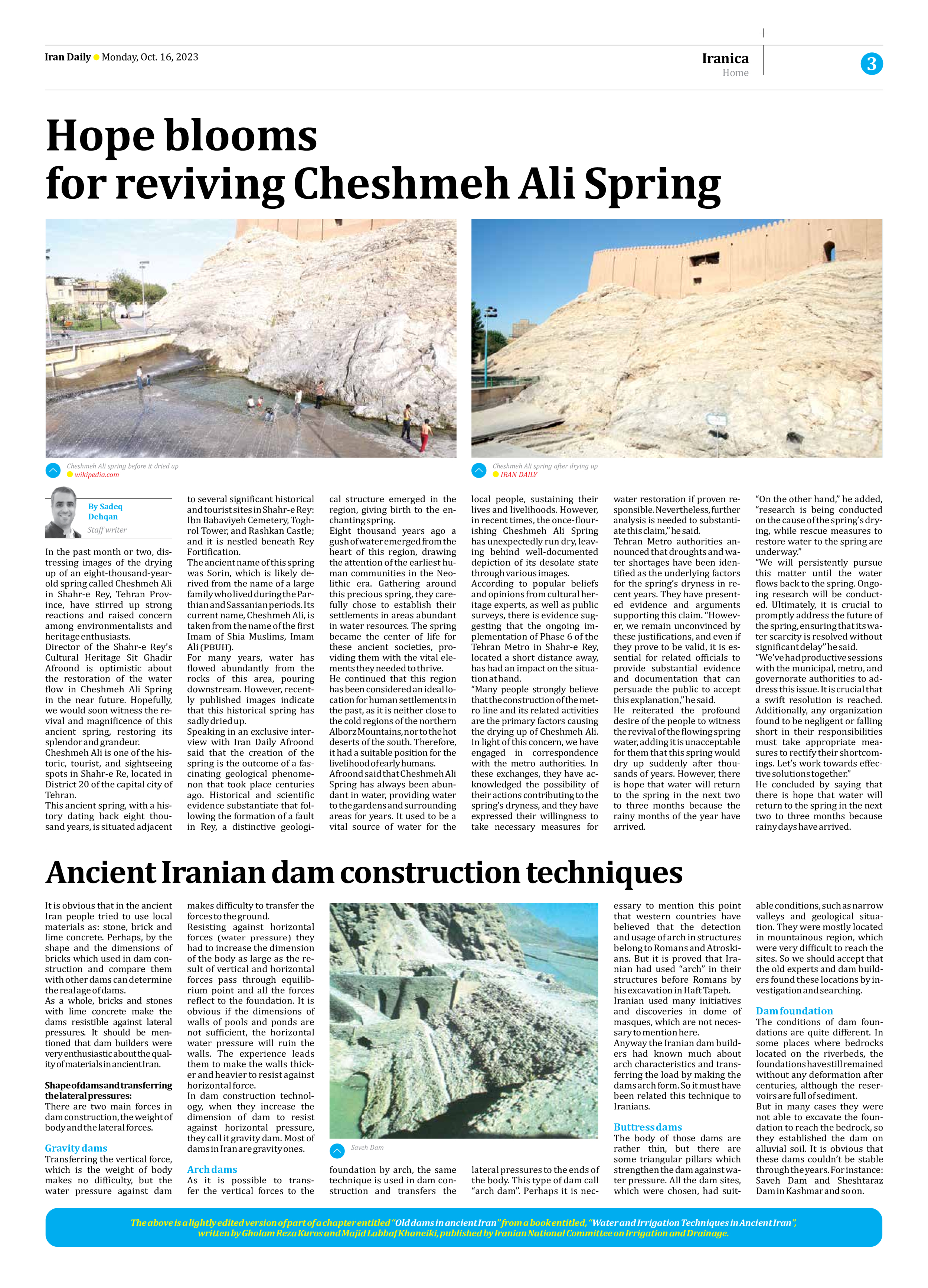
Hope blooms for reviving Cheshmeh Ali Spring
By Sadeq Dehqan
Staff writer
In the past month or two, distressing images of the drying up of an eight-thousand-year-old spring called Cheshmeh Ali in Shahr-e Rey, Tehran Province, have stirred up strong reactions and raised concern among environmentalists and heritage enthusiasts.
Director of the Shahr-e Rey’s Cultural Heritage Sit Ghadir Afroond is optimistic about the restoration of the water flow in Cheshmeh Ali Spring in the near future. Hopefully, we would soon witness the revival and magnificence of this ancient spring, restoring its splendor and grandeur.
Cheshmeh Ali is one of the historic, tourist, and sightseeing spots in Shahr-e Re, located in District 20 of the capital city of Tehran.
This ancient spring, with a history dating back eight thousand years, is situated adjacent to several significant historical and tourist sites in Shahr-e Rey: Ibn Babaviyeh Cemetery, Toghrol Tower, and Rashkan Castle; and it is nestled beneath Rey Fortification.
The ancient name of this spring was Sorin, which is likely derived from the name of a large family who lived during the Parthian and Sassanian periods. Its current name, Cheshmeh Ali, is taken from the name of the first Imam of Shia Muslims, Imam Ali (PBUH).
For many years, water has flowed abundantly from the rocks of this area, pouring downstream. However, recently published images indicate that this historical spring has sadly dried up.
Speaking in an exclusive interview with Iran Daily Afroond said that the creation of the spring is the outcome of a fascinating geological phenomenon that took place centuries ago. Historical and scientific evidence substantiate that following the formation of a fault in Rey, a distinctive geological structure emerged in the region, giving birth to the enchanting spring.
Eight thousand years ago a gush of water emerged from the heart of this region, drawing the attention of the earliest human communities in the Neolithic era. Gathering around this precious spring, they carefully chose to establish their settlements in areas abundant in water resources. The spring became the center of life for these ancient societies, providing them with the vital elements they needed to thrive.
He continued that this region has been considered an ideal location for human settlements in the past, as it is neither close to the cold regions of the northern Alborz Mountains, nor to the hot deserts of the south. Therefore, it had a suitable position for the livelihood of early humans.
Afroond said that Cheshmeh Ali Spring has always been abundant in water, providing water to the gardens and surrounding areas for years. It used to be a vital source of water for the local people, sustaining their lives and livelihoods. However, in recent times, the once-flourishing Cheshmeh Ali Spring has unexpectedly run dry, leaving behind well-documented depiction of its desolate state through various images.
According to popular beliefs and opinions from cultural heritage experts, as well as public surveys, there is evidence suggesting that the ongoing implementation of Phase 6 of the Tehran Metro in Shahr-e Rey, located a short distance away, has had an impact on the situation at hand.
“Many people strongly believe that the construction of the metro line and its related activities are the primary factors causing the drying up of Cheshmeh Ali. In light of this concern, we have engaged in correspondence with the metro authorities. In these exchanges, they have acknowledged the possibility of their actions contributing to the spring’s dryness, and they have expressed their willingness to take necessary measures for water restoration if proven responsible. Nevertheless, further analysis is needed to substantiate this claim,” he said.
Tehran Metro authorities announced that droughts and water shortages have been identified as the underlying factors for the spring’s dryness in recent years. They have presented evidence and arguments supporting this claim. “However, we remain unconvinced by these justifications, and even if they prove to be valid, it is essential for related officials to provide substantial evidence and documentation that can persuade the public to accept this explanation,” he said.
He reiterated the profound desire of the people to witness the revival of the flowing spring water, adding it is unacceptable for them that this spring would dry up suddenly after thousands of years. However, there is hope that water will return to the spring in the next two to three months because the rainy months of the year have arrived.
“On the other hand,” he added, “research is being conducted on the cause of the spring’s drying, while rescue measures to restore water to the spring are underway.”
“We will persistently pursue this matter until the water flows back to the spring. Ongoing research will be conducted. Ultimately, it is crucial to promptly address the future of the spring, ensuring that its water scarcity is resolved without significant delay” he said.
“We’ve had productive sessions with the municipal, metro, and governorate authorities to address this issue. It is crucial that a swift resolution is reached. Additionally, any organization found to be negligent or falling short in their responsibilities must take appropriate measures to rectify their shortcomings. Let’s work towards effective solutions together.”
He concluded by saying that there is hope that water will return to the spring in the next two to three months because rainy days have arrived.







